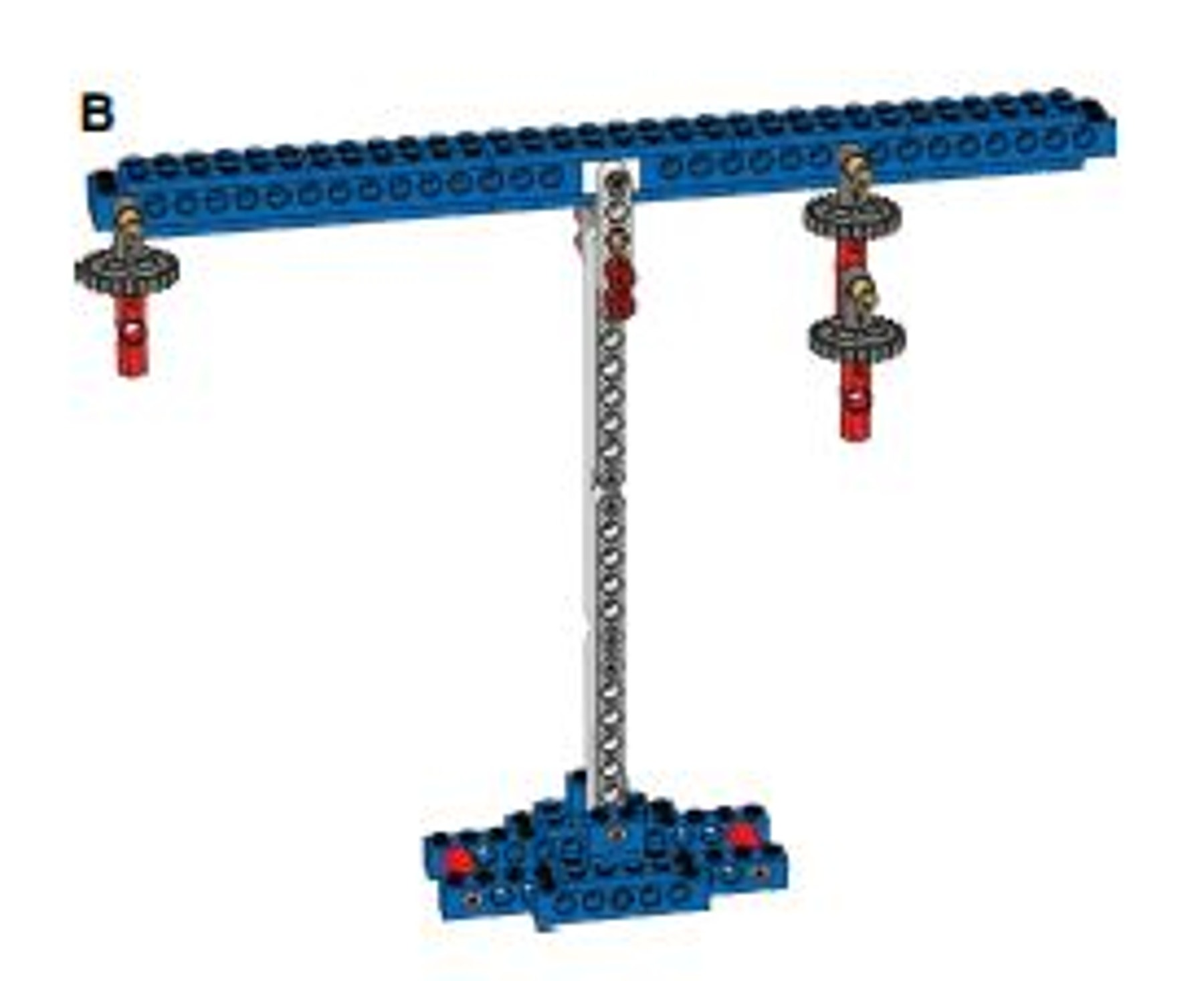Beam Balance
Explore the scientific concepts of levers, forces, effects of loads and solve problems involving scale factors.

Connect
(5-10 Minutes)
The simplest weighing machine is a beam balance. The original form of a balance consisted of a beam with a fulcrum at its center. A change of weigh on either side of the balance will change the beams positioning and effect the balance achieved.
You will build a model beam balance and investigate how its function is influenced by changes in weight and position.

Construct
(20-25 Minutes)
Build the Beam Balance and Loads
(building instructions 15A and 15B to page 9, step 9)
Make sure the arm moves up and down freely and the beam balance is in a state of equilibrium.

Contemplate
(20-25 Minutes)
Why is it in a state of equilibrium?
Place the load and efforts as shown and use the formulas for levers to find the mechanical advantage and to explain what happens.
First, observe the mechanical advantage of beam balance A.
Record the mechanical advantage on the worksheet.
Hint:
You can find all of the formulas you need to perform this investigation in the principle models section for lever.
Then use the formula for calculating the amount of effort needed to lift a given load to explain why the beam balance is in a state of equilibrium.
Record your findings on the worksheet.
Hint:
Use this formula to help explain why each model is balanced: effort x length of effort arm = load x length of load arm.

Next, follow the same procedure for beam balances B and C.
Beam balance A (page 10, step 10) presents a mechanical advantage of 1. The beam balance is in a state of equilibrium because the weight on each side of the fulcrum is the same and the distance of the weight from the fulcrum on each side is the same.
Did you know?
The loads weigh 2 g each.

Beam balance B (page 11, step 11) presents a mechanical advantage of 2. The beam balance is in a state of equilibrium, because the weight on the left of the fulcrum is half the weight on the right but it is twice as far from the fulcrum as the weight on the right.

Beam balance C (page 12, step 12) presents a mechanical advantage of 3. The beam balance is in a state of equilibrium because the weight on the left of the fulcrum is one third the weight on the right but it is three times as far from the fulcrum as the weight on the right.

Continue
(25-30 Minutes)
How much does it weigh?
Your challenge is to use the balance to work out the weight of assembly A.
First, put assembly A on one arm and the preassembled weights on the other arm to find the position where the balance is in equilibrium.
Hint:
Use this formula for calculating the amount of effort needed to lift a given load: effort x length of effort arm = load x length of load arm.

Then use these positions to calculate the weight of assembly A.
Next, use the calibrated weighing machine to check your accuracy.
Record and explain your findings on the worksheet.
Build your own set of weights from LEGO® parts and test their accuracy.
Hint:
Find out how accurate your calculation was by finding the difference between the actual and calculated weight. Then divide the difference with the actual weight and multiply it by 100.
Teacher Support
Students will explore the concepts of:
Science
Experiment and measure the effect of force on an object
Forces
Scientific investigation
Simple machines – Lever
Technology
Assembling components
Construct simple machines
Evaluating
Mechanical advantage
Properties of materials
Engineering
Describe and explain parts of a structure and the effects of loads
Test and evaluate before making improvements
Mathematics
Determine percent of error
Develop, analyze, and explain methods for solving problems involving proportions, such as scaling and finding equivalent ratios
Select and apply techniques to accurately find length measures to appropriate levels of precision
Solve problems involving scale factors, using ratio and proportion
9686 Simple & Powered Machines Set (two students per set recommended)
Measuring tape
Calibrated weighing machine
Crosscutting Concepts
Cause and effect: Mechanism and explanation
Scale, proportion, and quantity
Systems and system models
Structure and Function
Stability and change
Science and Engineering Practices
Developing and using models
Planning and carrying out investigations
Analyzing and interpreting data
Using mathematics, Informational and Computer Technology, and computational thinking
Constructing explanations and designing solutions
Common Core Mathematics Standards
MP4 / 7.EE.B
Common Core English Language Arts
SL 6.1 / SL 6.4 / SL 6.6 / SL 7.1 / SL 7.4 / SL 8.1 / SL 8.4 / SL 8.6
RST 6-8.1 / RST 6-8.2 / RST 6-8.3 / RST 6-8.4 / RST 6-8.5 / RST 6-8.10
WHST 6-8.2 / WHST 6-8.4
Student Material
Share with:
 Google Classroom
Google Classroom



